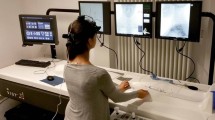Abstract
Radiology registrars were observed performing a left renal artery angioplasty using a proprietary training simulator up to five times during their first year of training. Total procedure time, fluoroscopy times, and metric information from the machine were recorded. Each step of the procedure was judged by an observer and a mistake profile was generated. Fifty-two runs were completed by 12 trainees. The mean procedure time decreased from 16.6 min to 9.8 min over the five runs. The number of mistakes ranged from zero to ten and the mean number of mistakes made varied from 0.7 to 2.6 per procedure without any particular trend. Our study demonstrates that training on the simulator does improve performance. The mistakes made throughout training indicates the potential benefit from further simulator training. It remains unclear how to integrate this form of training in current educational programs.


Similar content being viewed by others
References
Bradley P (2006) The history of simulation in medical education and possible future directions. Med Educ 40:254–262
Saied N (2005) Virtual reality and medicine. From the cockpit to the operating room: are we there yet? Mo Medicine 102:450–455
Dewey L (2005) Will modernised medical careers produce a better surgeon? BMJ 331:1346
Seymour NE, Gallagher AG, Roman SA et al (2002) Virtual reality training performance improves operating room performance. Ann Surg 236:458–464
Kneebone RL, Nestel D, Moorthy K et al (2003) Learning the skills of flexible sigmoidoscopy — the wider perspective. Med Educ 37:50–58
Satava RM (1993) Virtual reality surgical simulator: the first steps. Surg Endosc 7:203–205
Hanna GB, Frank TG, Cuschieri A (1997) Objective assessment of endoscopic knot quality. Am J Surg 174:410–413
Dayal R, Faries PL, Lin SC et al (2004) Computer simulation as a component of catheter-based training. J Vasc Surg 40:1112–1116
Hsu JH, Younan D, Pandalai S et al (2004) Use of a computer simulation for determining endovascular skill levels in a carotid stenting model. J Vasc Surg 40:1118–1125
Gallagher AG, Cates CU (2004) Approval of virtual reality training for carotid stenting. What this means for procedural-based medicine. JAMA 292:3024–3026
Healy GB (2002) The College should be instrumental in adapting simulators to education. Bull Am Coll Surg 8:10–12
Haque S, Srinivasan S (2006) A Meta-Analysis of the training effectiveness of virtual reality surgical simulators. IEEE Trans Inf Technol Biomed 10:51–58
Gould DA, Reekers JA, Kessel DO et al (2006) Simulation Devices in Interventional Radiology: Caveat Emptor. Cardiovasc Interv Radiol 29:4–6
Chaer RA, Derubertis BG, Lin SC et al (2006) Simulation improves resident performance in catheter-based intervention: results of a randomized, controlled study. Ann Surg 244:343–352
Dawson DL, Meyer J, Lee ES, Pevec WC (2004) Training with simulation improves residents’ endovascular procedural skills. J Vasc Surg 45:149–154
Neequaye SK, Aggarwal R, Brightwell R et al (2007) Identification of skills common to renal and iliac endovascular procedures performed on a virtual reality simulator. Eur J Endovasc Surg 33:525–532
Duncan J, Glaiberman CB (2007) Analysis of simulated angiographic procedures. Part 2: Extracting efficiency data from audio and video recordings. J Vasc Interv Radiol 18:535–554
Evans A (2002) Are we really as good as we think we are? Ann R Coll Surg Engl 84:54–56
Dankelman J, Wentink M, Grimbergen CA et al (2004) Does virtual reality training make sense in interventional radiology? Training skill-, rule- and knowledge-based behaviour. Cardiovasc Interv Radiol 27:417–421
Gallagher AG, Ritter EM, Champion H et al (2005) Virtual reality simulation for the operating room. Proficiency-based training as a paradigm shift in surgical skills training. Ann Surg 241:364–372
Kneebone R (2005) Evaluating clinical simulations for learning procedural skills: a theory-based approach. Acad Med 80:549–553
Johnson S, Healey A, Evans J et al (2006) Physical and cognitive task analysis in interventional radiology. Clin Radiol 61:97–103
Smith MK. (2001) David A. Kolb on experiential learning. [Online]. The encyclopedia of informal education. Available: http://www.infed.org/b-explrn.htm
Duncan J, Glaiberman CB (2006) Analysis of simulated angiographic procedures: Part 1—Capture and presentation of audio and video recordings. J Vasc Interv Radiol 17:1979–1919
Author information
Authors and Affiliations
Corresponding author
Rights and permissions
About this article
Cite this article
Klass, D., Tam, M.D.B.S., Cockburn, J. et al. Training on a vascular interventional simulator: an observational study. Eur Radiol 18, 2874–2878 (2008). https://doi.org/10.1007/s00330-008-1090-y
Received:
Accepted:
Published:
Issue Date:
DOI: https://doi.org/10.1007/s00330-008-1090-y




